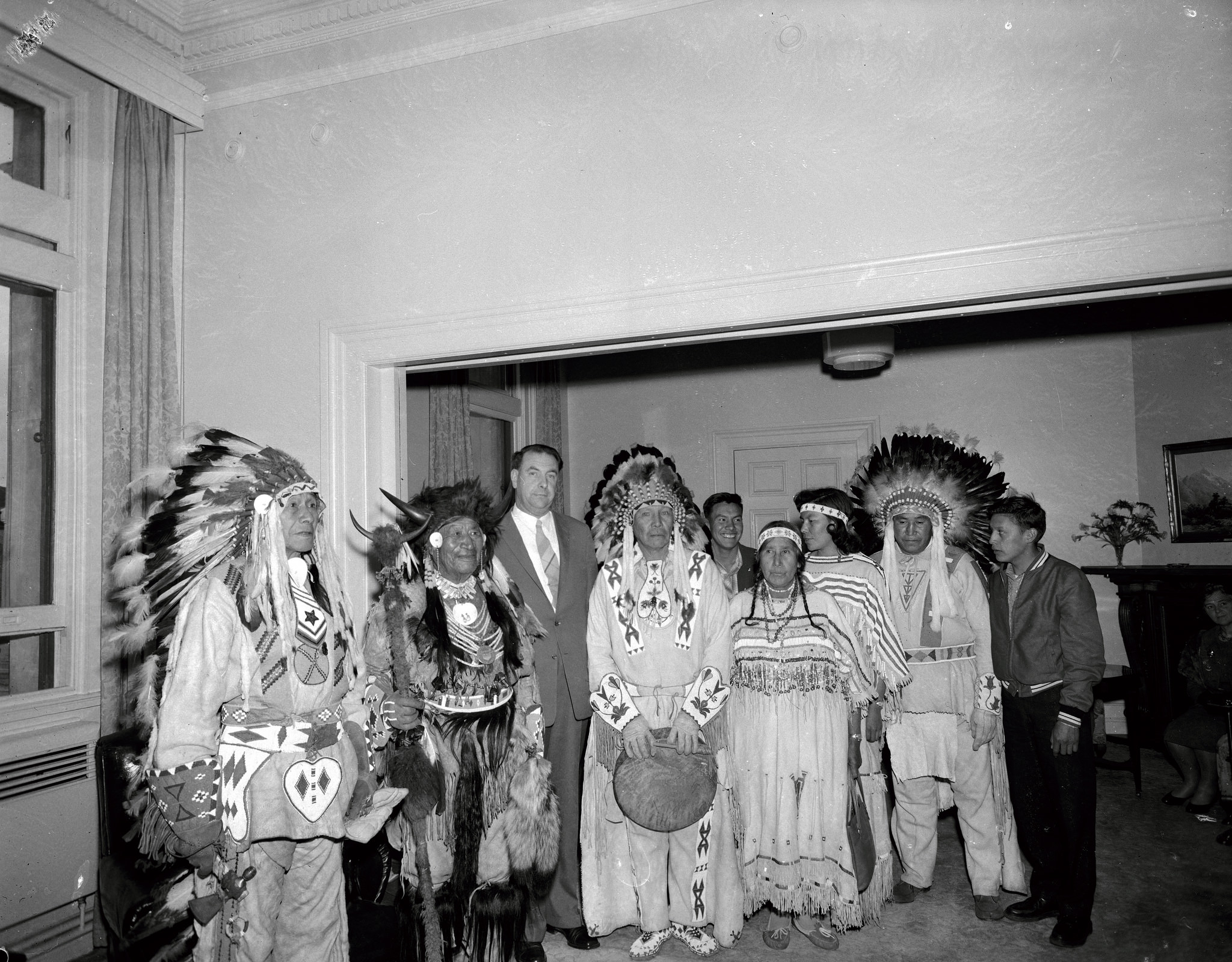Walking Buffalo (born Tatanga Mani, also known as George McLean), Stoney-Nakoda leader, statesman, philosopher (born 20 March 1870 in the Bow River Valley near Morley, AB; died 27 December 1967 in Banff, AB). Walking Buffalo was present at the signing of Treaty 7 (1877) and later served as a respected leader in Bearspaw First Nation until his death. Walking Buffalo preached world peace and, in 1959, journeyed around the globe to spread this word. He was a strong advocate for protecting the environment and Indigenous rights and culture.

Early Life and Education
Walking Buffalo was raised by his grandmothers on Stoney-Nakoda lands for the first eight years of his life. His mother had died shortly after his birth.
When he was only six, Walking Buffalo attended the signing of Treaty 7 with his family. As with the other Numbered Treaties, Treaty 7 created reserves and surrendered traditional territory in exchange for various promises from the government, including special rights to treaty lands and the distribution of cash payments. (See also Treaties with Indigenous Peoples in Canada.)
In 1881, Reverend John MacLean (sometimes spelled McLean) — a Methodist missionary in Morley — adopted a young Walking Buffalo, presumably after the death of his grandmothers, and gave him the name George McLean. Walking Buffalo attended school at the McDougall Orphanage and then at schools in Red Deer and Winnipeg.
Indigenous Leadership
Walking Buffalo returned to his reserve to serve as councillor for the Bearspaw First Nation from 1907 to 1916. He was elected chief in 1920 and served in this role until 1935. Even after, he remained an active member of his First Nation as well as of the Indian Association of Alberta. (See also Indian and Indigenous Political Activism and Organization in Canada.)
A champion of treaty rights, in 1918, Walking Buffalo and other Stoney-Nakoda leaders successfully stood up to the Calgary Power Company, which had owed money to the Stoney-Nakoda for surrendered traditional land which the power company planned to develop. A respected and strong leader, Walking Buffalo was dedicated to protecting his people, the land and the environment. (See also Rights of Indigenous Peoples in Canada.)
For years until his death, Walking Buffalo was actively involved in the Banff Indian Days and the Calgary Stampede, where he proudly showcased his Stoney-Nakoda heritage to the world.
DID YOU KNOW?
Walking Buffalo remained involved in the United Church and, in 1952, became the official caretaker of the church building in Morley. Despite his dedication to the church, Walking Buffalo was critical of Christian missionaries who misunderstood Indigenous spirituality and tried to eradicate traditional beliefs and practices. He said, “The white man meant well. Many of the missionaries were my friends, but they underestimated the Indian faith when they used fear to make us change.”
Moral Re-Armament
In 1934, Walking Buffalo met Frank Buchman, a leader in a spiritual and international organization known as Moral Re-Armament (now Initiatives of Change). Inspired by the organization’s call for world peace, Walking Buffalo became an ambassador for the movement.
In November 1959, he began a seven-month journey, travelling to 18 countries around the world, speaking about Moral Re-Armament. His main message was to “stop hating each other and start being brothers the way the Great Spirit intended.” During this tour, Walking Buffalo wore Stoney-Nakoda regalia, proudly showcasing his people and heritage to the world.
Death and Legacy
Walking Buffalo died on 27 December 1967. He entrusted his regalia — including the bison-horned headdress he often wore — to his close friend, Catharine (née Robb) Whyte. Catharine and her husband Peter Whyte were artists living in Banff. In 1968, the Whyte Museum of the Canadian Rockies was created on their property, and it is now where Walking Buffalo’s regalia resides.
During his lifetime, Walking Buffalo saw many social, political and economic changes to his homeland. He witnessed the disappearance of the bison, the creation of treaties and settler encroachment on traditional territories. During these difficult times, Walking Buffalo worked to protect his people and his culture.
He also leaves behind a legacy as a promoter of world peace. As former lieutenant-governor of Alberta Grant MacEwan (1965–74) wrote about Walking Buffalo, “Whether spoken in tipi or temple, his message of love and respect for fundamental human dignity would never dim.”

 Share on Facebook
Share on Facebook Share on X
Share on X Share by Email
Share by Email Share on Google Classroom
Share on Google Classroom




